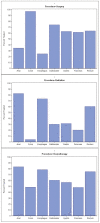Survival According to Primary Tumor Location, Stage, and Treatment Patterns in Locoregional Gastroenteropancreatic High-grade Neuroendocrine Carcinomas
- PMID: 35380711
- PMCID: PMC8982433
- DOI: 10.1093/oncolo/oyab039
Survival According to Primary Tumor Location, Stage, and Treatment Patterns in Locoregional Gastroenteropancreatic High-grade Neuroendocrine Carcinomas
Abstract
Background: Although the gastrointestinal tract (including the pancreas, gastroenteropancreatic (GEP) is the most common site for extrapulmonary neuroendocrine carcinoma (NEC), the current treatment patterns of locoregional GEP NEC and in particular, the role of surgical resection is unclear.
Methods: Data from the National Cancer Database between 2004 and 2016 were used for this study.
Results: Of 2314 GEP NEC cases (stages I-III), 52.5% were stage III. Colon was the most common site (30%); 30.9% of all cases were small cell morphology. Age, morphology, stage, and primary site were associated with significant differences in treatment patterns. Management of NEC mimicked that of adenocarcinomas arising at the respective sites: colon NEC most likely to be treated with surgery and chemotherapy; anal and esophageal NEC was primarily likely to receive chemotherapy and radiation, and rectal NEC mostly likely to receive trimodality therapy. However, 25%-40% of patients did not undergo surgical resection even at sites typically managed with curative resection, and there was a trend toward lesser resection over time. The prognostic impact of surgical resection was significant across all stages and correlated with variations in survival across primary sites. Even in patients undergoing chemoradiation, surgery was the only prognostic variable that significantly affected survival in stages I-II patients (HR 0.63) and showed a strong trend in stage III (HR 0.77) patients.
Conclusions: Treatment patterns in GEP NEC vary considerably according to stage and primary tumor site. Surgery significantly improved survival in stages I-II patients and showed a strong trend in stage III patients regardless of primary tumor location and other perioperative therapies.
Keywords: NCDB; large cell; neuroendocrine carcinoma; poorly differentiated; small cell.
© The Author(s) 2022. Published by Oxford University Press.
Figures
References
-
- Klimstra DS, Modlin IR, Coppola D, Lloyd RV, Suster S.. The pathologic classification of neuroendocrine tumors: a review of nomenclature, grading, and staging systems. Pancreas. 2010;39(6):707-712. - PubMed
-
- Soto DE, Eisbruch A.. Limited-stage extrapulmonary small cell carcinoma: outcomes after modern chemotherapy and radiotherapy. Cancer J. 2007;13(4):243-246. - PubMed
-
- Travis WD, Brambilla E, Nicholson AG, et al. ; WHO Panel . The 2015 World Health Organization Classification of lung tumors: impact of genetic, clinical and radiologic advances since the 2004 classification. J Thorac Oncol. 2015;10(9):1243-1260. - PubMed
Publication types
MeSH terms
Grants and funding
LinkOut - more resources
Full Text Sources
Medical


